12. Vulnerable Groups of Young People
| Reports - Annual Report Bulgaria |
Drug Abuse
12. Vulnerable Groups of Young People
Introduction
Within the frames of the common European space the European Commission undertook activities to develop the all-European Children's Rights Strategy as well as to administratively provide the new policies. In this way the EU clearly identified the assistance for the children's rights as a specific field, deserving special activities.
Pursuant to Art.136 and Art.137 from the Amsterdam Treaty from 1997 over the last years the EU undertook important activities to combat poverty and social isolation. At the meeting of the European Council in Lisbon in 2000 the EU set itself the task of becoming "the most competitive and dynamic knowledge-based economy in the world, with more and better jobs and a greater social cohesion" 87. Also adopted was the "An Open Method of Social Protection and Social Inclusion." Child care represents one of its most important parts.
Besides, the Open Method of coordination is used as a mechanism of mutual involvement among the member-countries and for learning from the good practices when applying the UN Convention on the Rights of the Child.
The situation of the children, as well as the current situation of the Bulgarian population is the result of the continuous effect of a lot of factors and influences. Some of them are related to the common trends characteristic of the European countries, others - to the specific particularities of the historical, economic and the cultural development of the country.
Social and Demographic Characteristics of the Types of Subgroups
Institutionalized children
In the Supplementary Provisions to the Child Protection Act in the Republic of Bulgaria the national definition of the concept "Specialized Institutions" is given.
Specialized institutions are "boarding house — type of homes for upbringing and educating Children, where they are permanently separated from their home environment".
Over the last years Bulgaria made efforts to promote the welfare of the children and to adapt the system of child protection to the level of the international standards. Upbringing the child in the home environment is a basic principle, which the Bulgarian Child Protection Act implements through a system of rules and mechanisms. When compared to the previous years the total number of all the children institutionalized is dropping. These special institutions are: Homes for Upbringing and Educating Children Deprived of Parental Care (HUECDPC), the homes for disabled children — the Home for Mentally Disabled Children and Youths (HMDCY) and the Home for Physically Disabled and Mentally Unharmed Children and Youths (HPDMUCY) and Home for Medical and Social Care for Children (HMSCC).
The total number of the children at the specialized institutions in 2006 was 8 653. For comparison the number of all the children institutionalized is given in Table 12-1.
By 31st December 2006 at the Homes for Medical and Social Care for Children, where children aged from 0 to 3 years were reared (both healthy and disabled, and some disabled children stay there until they get 7 years old) was 2 743. At the Homes for Upbringing and Educating Children Deprived of Parental Care where children aged from 3 to 18 years are institutionalized, by 315t December 2006 the number of children was 4 717. At the homes for disabled children, where children aged 4 to 18 years are institutionalized, by 31st December 2006 the number of children was 1193. In comparison to 2005 the number of children institutionalized has decreased by 1 123 children, or by 11.5 %. The decrease over the last 6 years in the number of children institutionalized compared to the number of the total population of children in the country is insignificant - from 0.78 % in 2001 to 0.61 % in 2006.
Apart from the specialized institutions there are 9 Social and Pedagogic Boarding Schools (SPBS) and 5 Educational Schools — Boarding Schools (ESBS) where the children are institutionalized by order of the Act on Combating the Antisocial Deeds of Minors and Underage. These children numbered 600 in 2006 — nearly twice fewer in comparison to the previous year.
The total number of the children institutionalized and the children who are reared at these Pedagogic Boarding Schools and Educational Schools - Boarding Schools is 9 256, which is 0,65 % of the population of children in the country for the period. In comparison to the preceding year their part has diminished insignificantly - by 0.09 % 88
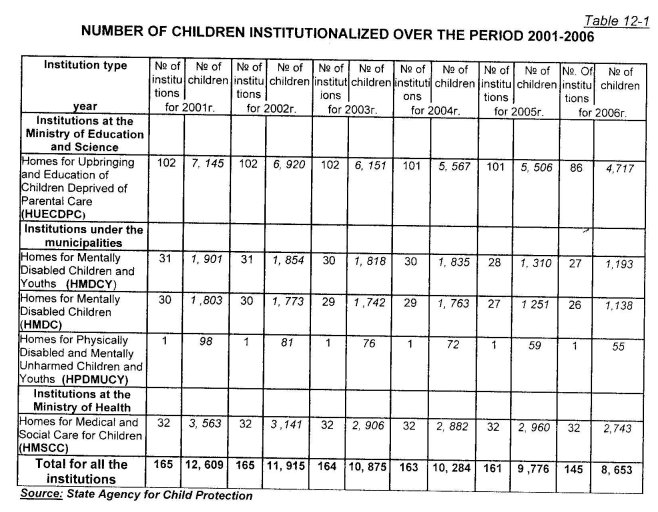
On the data of the State Agency for Child Protection in 2006 more than 80 % of the children institutionalized had families, and they were institutionalized because of impossibility to be reared at home or in an environment close to the family one. 89
School Dropouts and Students Who Cannot Manage the Syllabus
The fact is disturbing that alongside with the existing common trend of decreasing birth rate the relative number of school dropouts remains great over the last years. On the data of the regional inspectorates on education for the 2004/2005 school year there were 19 193 dropouts from a total of 963 051 students enrolled at the beginning of the school year. In 2003/2004 the number of dropouts was 31 552. In 2002/2003 the number of dropouts was 31 002.
On the data of the State Agency of Youth and Sports the school dropouts in the school year 2006/2007 represented 10,3% of the youths aged 15-19 years. Represented in figures this means that nearly 30 000 youths do not finish and will not finish their secondary education (see Figure12- 1). The reasons for this disturbing phenomenon can be grouped in four basic categories: economic, ethnic and cultural, social and pedagogic. The main factors for dropping out from school are the economic status of the family, the ethnic identity, and also the school environment and the related to it pedagogic factors 90.
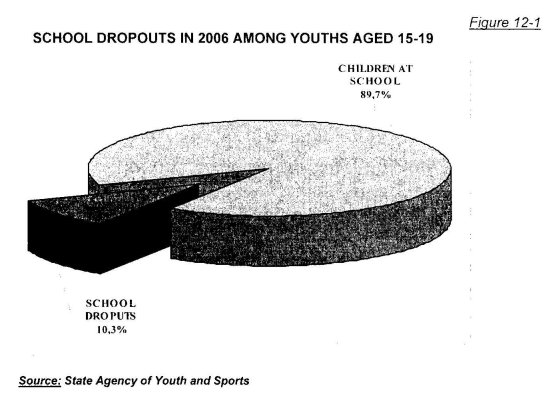
Homeless Children
On the data presented by the State Agency for Child Protection the number of children who have been to the centers for waifs and strays in 2006 was 280, or that is 34 fewer than in 2005 and 251 fewer than in 2004. The distribution according to gender gives the following information: 151 boys and 129 girls (see Table 1,2-2).
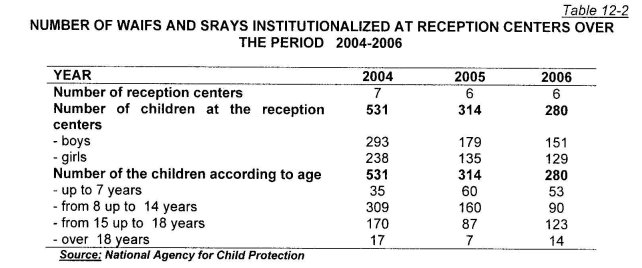
Contrary to the trend of reducing the number of children institutionalized, there was a constant tendency in 2006 of increasing the number of children who have been to the already existing and to the newly established day centers in Bulgaria (see Table 12-3). According to the data of the State Agency for Child Protection the number of the actually functioning day centers in Bulgaria in 2006 was 9. For the entire period from January to December last year a total of 332 have been there (153 girls and 179 boys).

The centers for temporary institutionalization in Bulgaria are 4 — 2 are in Sofia, 1 in Varna and 1 in Plovdiv. In 2006 the children institutionalized there numbered 95 - 34 girls and_61 boys (see Table 12-4).
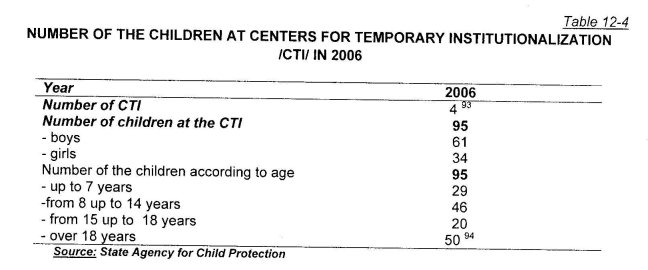
Juvenile Offenders
In the year 2006 15 969 under age and minors were registered at the Children's Pedagogic Services /CPS/ (in 2005 they numbered 17,390 or 8.2 % fewer). The number of the underage and minors, registered in 2006 was 4 830 or 9.7 % fewer in comparison to the preceding year. The girls registered were 2697, which is 11.1 °A fewer in comparison to 2005. Persons aged 14-17 were 12632 (79,1 % of the total number the underage and minors registered), which in comparison to 2005 marks a decrease of 6.3 %. The number of persons registered aged 8-13 years was 3 337 (in 2005 they numbered 3 913 or 14.7 % fewer) 95.
In 2006 the number of the underage and minors, who have been at the CPS for vagrancy and begging decreased by 36.6 `)/0 (from 1 537 in 2005 to 975 in 2006). Vagrancy and begging are a more common phenomenon among the minors in comparison to the underage. The number of persons aged 14-17 years, who have been registered at the CPS for vagrancy and begging was 533, while for the underage the respective figure was 442.
On the data of the National Institute of Statistics in 2006 the number of truants increased by 25.4 % (from 1 888 in 2005 to 2 367 in 2006). Alongside there was a decrease in the number of the minors and underage who have been at the CPR for prostitution and homosexuality by 20.2 °A (from 501 children in 2005 to 400 in 2006), for drug use by 19.0 % (from 584 children in 2005 to 473 children in 2006) and for alcohol consumption by 18.7 % (from 802 children in 2005 to 652 children in 2006).
The number of underage and minors, registered at the CPS as juvenile offenders decreased in comparison to 2005 by 12.1 % (from 9 720 in 2005 to 8 541 in 2006). In comparison to 2005 the number of children who have committed larceny dropped by 6.7 % (from 6 304 in 2005 to 5 883 in 2006). There is also a decrease in the number of children who have committed robberies by 12.3 % (from 2 593 in 2005 to 2 274 in 2006). The children pickpockets were 737, which is 42.6 % fewer than in 2005.
The number of juvenile offenders registered for robberies committed was 401, which is 36.9 % fewer in comparison to 2005, when they numbered 635. At the same time there is an increase in the number of juvenile offenders who have perpetrated rape (by 44.4 %), carnal abuse (by 25.0 %), and bodily harm (by 8.2 %).
Children living in deprived places and/or with high drug availability
On the data of the National Institute of Statistics the social characteristics of the minors and underage persons registered at the Children's Pedagogic Services are similar to those of the previous years. 11,774, or 73.7 % of the children who have been registered at the CPS had lived in unfavorable conditions (in 2005 they numbered 10, 842). Those are the children of divorced parents or practically separated parents, children of socially underprivileged families, orphans or children with a single parent alive, children who had lived in conflict family environment, criminogenic family environment or criminogenic circle of friends. From the children registered in 2006 at the CPS 2,442 neither study nor work, and in comparison to 2005 there is an increase in their number of 0.7 points 96.
An important issue affecting the social characteristics of the minors and the underage members of each society is child poverty. The broadest concept of child poverty is the one used by the Innocenti Research Center of UNICEF with a basic reference to the UN Convention on the rights of children. According to this concept "child poverty is a situation in which the child has a standard of living not promoting his/her physical, mental, spiritual, moral or social development"." In this aspect the concept of poverty should not be only conceived as lack of funding. It acquires a new and much broader meaning, comprising concepts and ideas from different professional spheres.
Since the financial poverty remains a universal concept in understanding the quality of life in the community, in this section are included illustrative data on the social situation in the Republic of Bulgaria.
In 2002 the level of financial poverty in Bulgaria was 13.4 %. This is the lowest level of relative poverty since 1995 98. According to the Joint Memorandum on Social Inclusion of the Republic of Bulgaria and the National Report on the Strategies for Social Protection and Social Inclusion for the period 2006 — 2008 the children represent one of the main groups at risk of becoming poor. This risk is especially great for the children living in single-parent families or in families with many children (the risk of poverty is respectively 25.1 % and 31.5 %), as well as among the children from the vulnerable ethnic minorities 99.
In Bulgaria, as well as in the other countries from Southeastern Europe there is relatively low level of child poverty because of low income. According to the World Bank (2005), the rate of the poor children in Bulgaria under the age of 15 in 2003 was 8 %, (as a threshold of poverty is considered an income of $2.15 per capita per day).
The data for 2001 show that the part of the children living in extreme poverty is 1 'A for the capital Sofia and it reaches 1/4 of all the children in the region of the villages.lw
Ethnic Minorities
On the summarized data of the State Agency for Child Protection included in the working out of the draft of the National Strategy for the Child (2007-2017), the conclusion can be drawn that the representatives of the ethnic groups represent a great part of the population of the abovementioned vulnerable subgroups among the young people. This specially applies for the members of the Roma ethnic community.
Ethnicity is one of the main factors for dropping out of school. On the data of (he State Agency of Youth and Sports half of the youths aged from 15 to 19 who have dropped out from school are representatives of the Roma ethnic community (see Table 12-5). The ethnic belonging brings about observing specific cultural stereotypes, which have the strongest impact when the family lives in a compact group among the representatives of its own ethnos. The ethnic belonging has its impact on dropping out from school through economic motives for dropping out (low income, poor standard of living, unemployment, etc.), as well as through the so called family reasons (early marriages, incomplete families, etc.).
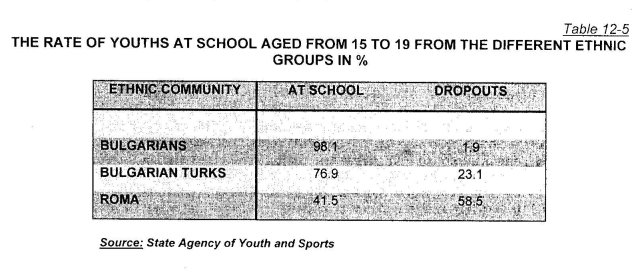
Poverty. because of low income and particularly child poverty because of low income in Bulgaria reflects the concentration of minorities in the different regions (Roma people, but also Turks). According to the conclusions of the Bulgarian Review of the integrated families 2001 the Roma population represents a little less than 9% of the total population of the country and more than 15 % of the child population, but more than 60 °A, of the children living in poverty because of low income, are Roma children Mi.
On the data of the State Agency for Child Protection the greatest part of the children institutionalized at the Homes for Medical and Social Child Care (HMSCC) and at the Homes for Upbringing and Education of Children Deprived of Parental Care (HUECDPC), again belong to the representatives of the Roma ethnic community (see Table 12-6).
The representatives of the ethnic minorities are an especially vulnerable group for traffic aimed at sexual exploitation, forced labour, begging, other illegal activities and for adoption, their part for 2003 represented 76.9 %, and for 2004 - 81.8 % 102.
Closely related to the standard of living at the households where the young people live is the access to healthcare and dental care. Especially grave is the situation with the dental care among the young Roma people. Nearly a third of the young people having dental problems can't afford to have their teeth cured, and for the Roma people this rate reaches up to 54 %. The access to dental care is limited for the Bulgarian Turks as well, although the problem here is not only financial. A great part of them live in the mountain regions and in villages difficult to reach and with poor communications, and for these people dental care is seldom available 103.

Children from Vulnerable Families
On the generalized data of the State Agency for Child Protection which are included in the National Strategy for the Child (2007-2017) now being drawn up the greatest part of the children at the specialized institutions is that of the single-parent families — 46 % (or 3 958 children). Despite decreasing the number of the children institutionalized in 2006 the number of the children of single or divorced parents increased by 187 or 5 % in comparison to 2005. If in 2005 those children represented 39 °A of the children institutionalized by 31st December in 2006 they were nearly 46 %. The fact that there is not a second parent to care for the child is a main risk for institutionalizing the child outside the family at an early age — 66 % (1 807) of the children institutionalized at the HMSCC come from single-parent families. At the homes for disabled children the relative part of the children of single or divorced parents is 39 % (464) of the total number of children institutionalized there by 31st December 2006. The relative part of this group of children is the smallest at the HUECDPC — 36 % (1 687)1°4.
The parents of 40 % (3 460) of the children are unemployed — they are of very low social status and cannot manage with upbringing their children. The children of large families represent 27% of the institutionalized children (2,328), and next come the children who have been abandoned by their parents and the foundlings — 15 % (1 322) and the children one of the parents of whom has died — 8,6 °A (742). 2 % of the children institutionalized are orphans - 174 children. At the specialized institutions there are 159 (1,8 %) children born by underage mothers under 18 years of age.105
87 National Strategy for the Child 2007-2017- Draft, 28th May 2007
88 Source: State Agency for Child Protection, National Strategy for the Child 2007-2017-draft, 28th May 2007
89 Source: State Agency for Child Protection, National Strategy for the Child 2007-2017-draft, 28th May 2007
90 State Agency for Child Protection, National Strategy for the Child, 2007-2017 - draft, 28th May 2007
91 Data have been taken from 9, because "I DC is not functioning.
92 These are not included in the total number of children.
93 in Sofia — city, 1 in Varna and I in Plovdiv.
94 The children from "Sv. Sofia" CTI are not included.
95 National Institute of Statistics, Antisocial deeds of minors and under age in 2006
96 National Institute of Statistics, Antisocial deeds of minors and persons under age in 2006
97 State Agency for Child Protection, National Strategy for the Child, 2007-2017 - Draft, 28th May.2007 on the data of Innocenti Social Monitor 2004. Economic Growth and Child Poverty in the CEE/CIS and the Baltic states.
98 State Agency for Child Protection, National Strategy for the Child 2007-2017 — Draft, 28th May 2007 on the data of the Joint Memorandum for social inclusion of the republic of Bulgariar. (2005-2010)
99 State Agency for Child protection , National Strategy for the Child 2007-2017 - Draft, 28"' May 2007 on the data from the National Report on the strategies for social protection and social inclusion of the republic of Bulgaria for the period 2006-2008
100 State Agency for Child Protection, National Strategy for the Child 2007-2017 - Draft, ze May 2007
101 State Agency for Child Protection, National Strategy for the Child 2007-2017 — Draft, 2810 May 2007
102 State Agency for Child Protection, National Strategy for the Child 2007-2017— Draft, 28th May 2007
103 State Agency of Youth and Sports
104 State Agency for Child Protection, National Strategy for the Child 2007-2017 - Draft, 28th May 2007
105 State Agency for Child Protection, National Strategy for the Child 2007-2017 - Draft, 281h May 2007
| < Prev | Next > |
|---|












